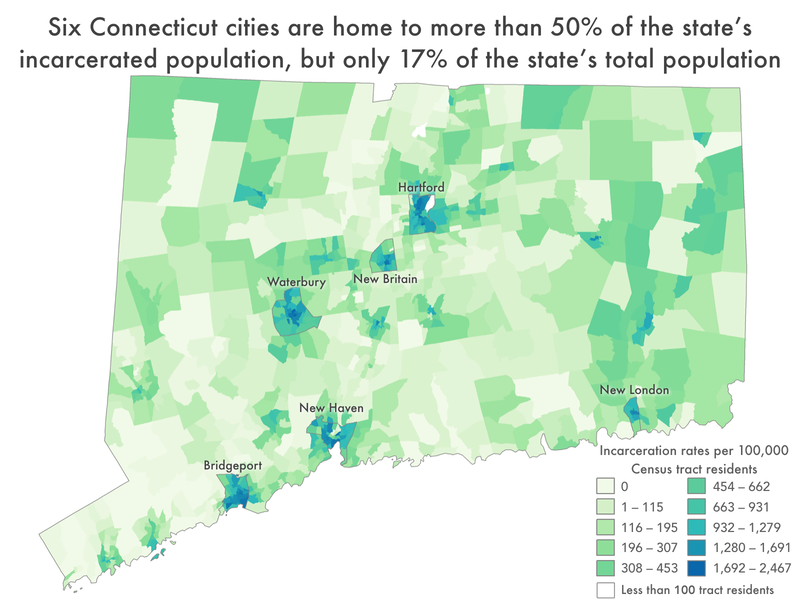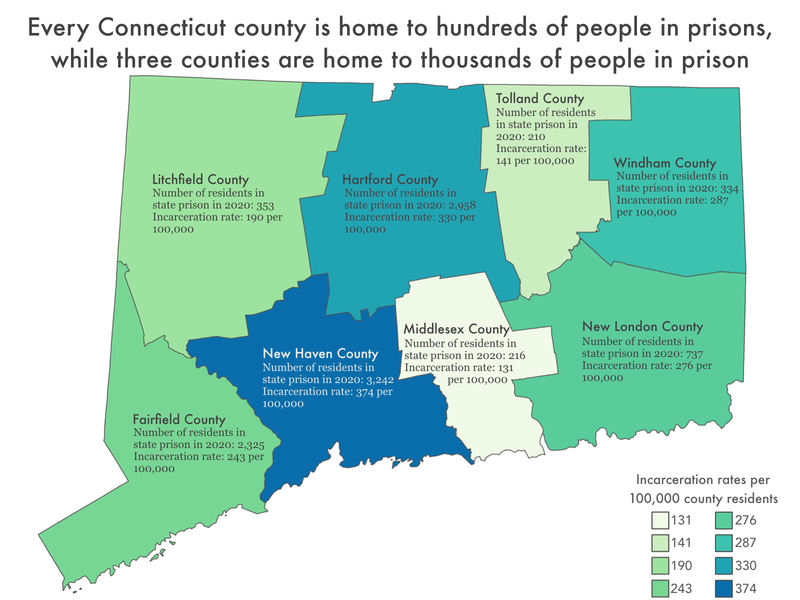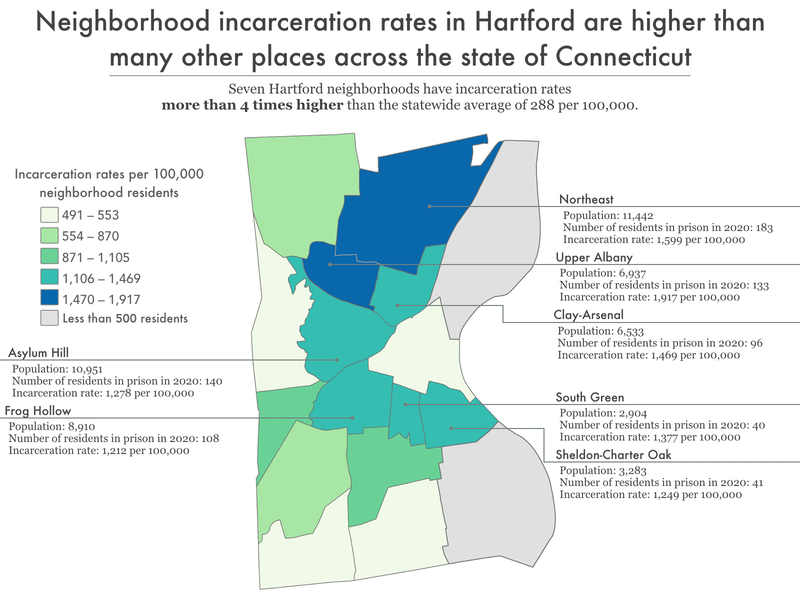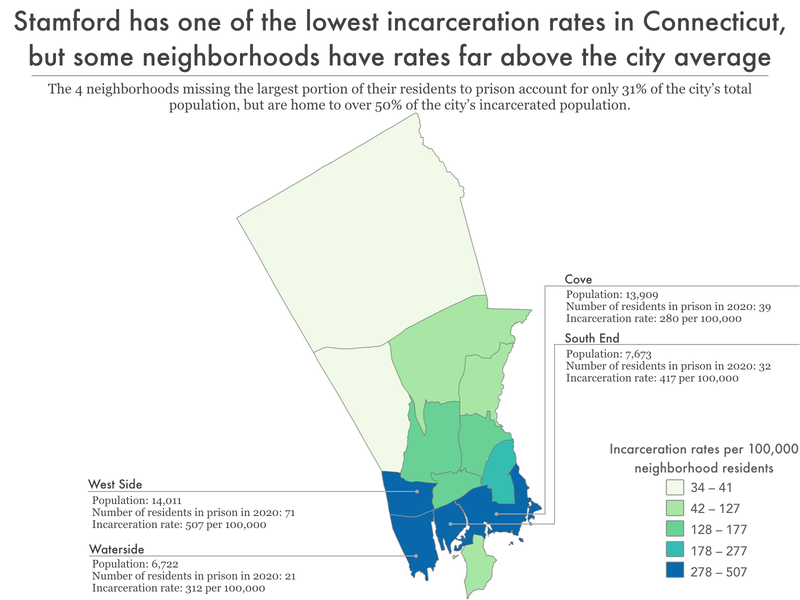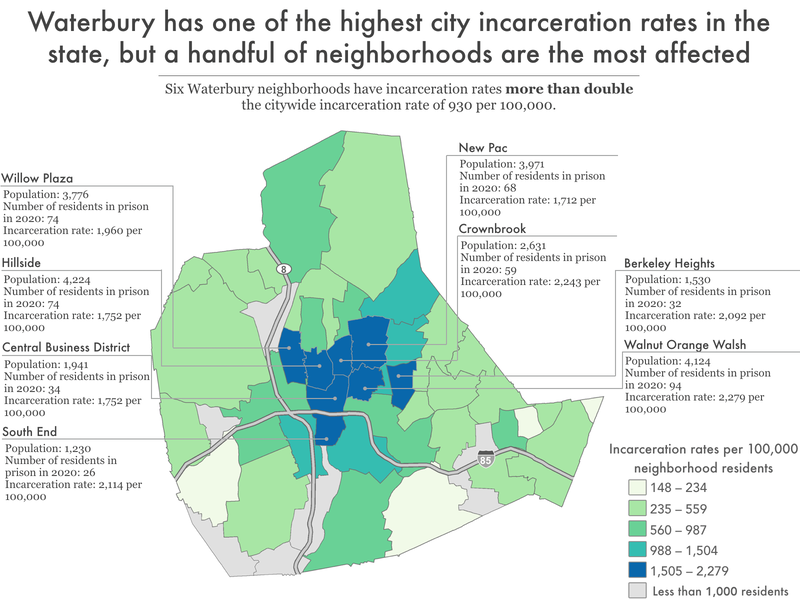Where people in prison come from:
The geography of mass incarceration in Connecticut
by Emily Widra, Keshia Morris Desir, Kennard Ray, and James Jeter
October 2022
Press release
One of the most important criminal legal system disparities in Connecticut has long been difficult to decipher: Which communities throughout the state do incarcerated people come from? Anyone who lives in or works within heavily policed and incarcerated communities intuitively knows that certain neighborhoods disproportionately experience incarceration. But data have never been available to quantify how many people from each community are incarcerated with any real precision.1
But now, thanks to redistricting reform — which aims to improve the way that electoral districts are drawn to ensure that everyone is fairly represented — incarcerated people are counted correctly in the legislative districts they come from, we can understand the geography of incarceration in Connecticut. Connecticut is one of over a dozen states that have ended prison gerrymandering, and now count incarcerated people where they legally reside — at their home address — rather than in remote prison cells. This type of reform, as we often discuss, is crucial for ending the siphoning of political power from disproportionately Black and Latino communities, to pad out the mostly rural, predominantly white regions where prisons are located. And when reforms like Connecticut’s are implemented, they bring along a convenient side effect: In order to correctly represent each community’s population counts, states must collect detailed state-wide data on where incarcerated people call home, which is otherwise impossible to access.
Using this updated redistricting data, we found that in Connecticut, incarcerated people come from all over the state, but are disproportionately from the cities of Bridgeport, Hartford, New Haven, and Waterbury. Looking at local level data, we find that within these high incarceration cities — and cities with much lower incarceration rates — there is significant neighborhood level variation in incarceration rates. In addition to helping policy makers and advocates effectively bring reentry and diversion resources to these communities, this data has far-reaching implications. Around the country, high incarceration rates are correlated with other community problems related to poverty, employment, education, and health. Researchers, scholars, advocates, and politicians can use the data in this report to advocate for bringing more resources to their communities.
Incarcerated people come from all over Connecticut — but disproportionately from some places more than others
More than 10,000 Connecticut residents are incarcerated,2 leaving the state with an incarceration rate of 288 per 100,000 Connecticut residents.3 While no part of Connecticut is immune to the consequences of the state’s reliance on mass incarceration, some communities are disproportionately impacted by incarceration.
County trends
Most broadly, we find that incarcerated people in Connecticut come from every corner of the state: almost every city and every state legislative district is missing someone to incarceration. The county with both the most incarcerated residents (3,242) and the highest incarceration rate (374 per 100,000), is the state’s third most populous county: New Haven.4 Connecticut’s second most populous county — Hartford — has the second highest county incarceration rate: 330 per 100,000 county residents. Among all eight Connecticut counties, Fairfield County — home to the most people in the state — has the fifth highest incarceration rate at 243 per 100,000.
City trends
There are five cities in Connecticut with populations greater than 100,000 people: Bridgeport, Stamford, New Haven, Hartford, and Waterbury. Among these cities, the highest incarceration rate is in Hartford, which has 1,294 city residents incarcerated at a rate of 1,065 per 100,000 people. Waterbury, Bridgeport, and New Haven also have relatively high citywide incarceration rates: 931, 903, and 801 per 100,000, respectively. However, Stamford stands out with a relatively low citywide incarceration rate of 214 per 100,000, which is lower than the statewide incarceration rate. Among these five large Connecticut cities, Stamford not only has the lowest incarceration rate, but it also has the lowest percentage of Black residents, Hispanic or Latino residents, and residents in poverty.
Across the country, the criminal legal system disproportionately and unfairly targets communities of color. This appears to be the case in Connecticut, as well. On April 1st, 2020, the Connecticut Department of Corrections reported that 27% of the prison population was Hispanic or Latino, while the statewide population was only 18% Hispanic or Latino. Similarly, 44% of the prison population was Black, but only 13% of Connecticut residents were Black. We also know that nationally, poor people, families, and communities are disproportionately impacted by the criminal legal system. Based on the significant differences between the racial and economic demographics of Stamford and the other four largest Connecticut cities, race and poverty appear to both be implicated in the high incarceration rates in Bridgeport, Waterbury, New Haven, and Hartford.
High incarceration rates are not confined to the most populous Connecticut cities, however. The significantly less populated cities of New London, New Britain, Norwich, and Torrington all have incarceration rates significantly above the statewide average. New London and New Britain have incarceration rates more than double that of the state: 798 per 100,000 and 683 per 100,000, respectively. Norwich and Torrington, each with less than 45,000 residents have incarceration rates of 531 and 401 per 100,000. Like the larger cities of Bridgeport, Waterbury, New Haven, and Hartford, all four of these less populous cities’ police arrest Black people at alarmingly high rates compared to the portion of the citywide populations that are Black.5 Inevitably, the same factors of race and poverty that we see impacting incarceration rates in Connecticut’s most populous cities are at play in these smaller cities as well, contributing to the high incarceration rates and the statewide racial disparities in incarceration.
Neighborhood trends
Within Connecticut cities, incarceration tends to be concentrated in a relatively small number of geographic areas and neighborhoods.
Hartford
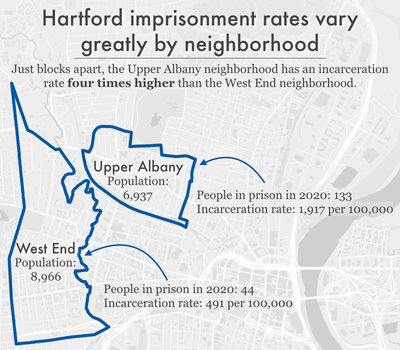
Nearby neighborhoods face drastically different rates of incarceration, implying that certain communities are particularly vulnerable.
Among the five most populous cities in Connecticut, Hartford has the highest portion of Black residents (37% of the city population), the highest portion of Hispanic or Latino residents (45%), and the highest poverty rate (28%).6 Given what we know about how policing targets low-income communities and communities of color, it may not be surprising that Hartford is missing more than 1% of its population to prisons. But the residence data available in this report allows us to take a look at even more of a local level: neighborhood incarceration rates.
Eight of the fifteen Hartford neighborhoods7 have incarceration rates above 1,000 people in prison per 100,000 neighborhood residents, suggesting that some neighborhoods are particularly vulnerable to the criminal-legal system.
Historically, Hartford is one of the starkest examples of redlining in the country. In the 1930s, the federal government rated the “riskiness” of real estate investment in different neighborhoods, resulting in rating non-white neighborhoods as “hazardous” and beginning a cycle of disinvestment in predominately Black and immigrant neighborhoods. A 2019 study of formerly redlined neighborhoods in over 100 cities found that these neighborhoods are lower-income and are more likely to be home to Black and Hispanic or Latino residents. In Hartford, the neighborhoods with the highest incarceration rates in 2020 are also the neighborhoods that were “redlined” in the mid-20th century. For example, the neighborhood of Upper Albany was considered “definitely declining” during redlining, resulting in the community becoming home to predominantly nonwhite residents. Today, Upper Albany is 85% Black, while the city of Hartford itself is only 37% Black. And compared to the West End neighborhood just to the southwest — parts of which were considered the “best” and “still desirable” for real estate investment during redlining — Upper Albany’s incarceration rate in 2020 was four times higher, suggesting that the long lasting consequences of the racist redlining practices of the 20th century persevere in modern day policing and incarceration trends.
Stamford
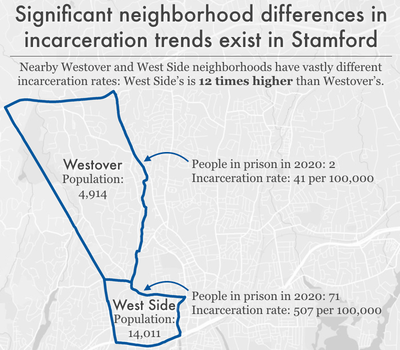
Stamford has one of the lowest citywide incarceration rates (214 per 100,000) and when compared to other large Connecticut cities , it also has the lowest percentage of Black residents (14%), Hispanic or Latino residents (27%), and residents in poverty (9%). But the same trends persist in Stamford as in the other cities: Black people are over four times more likely to be arrested for low level, non-violent offenses than a white person,8 and Black people account for a disproportionate 37% of the Stamford Police Department’s arrests.
Looking more closely, we see that areas with relatively high percentages of Black residents, relatively low percentages of white residents, and high unemployment rates have the highest neighborhood incarceration rates in Stamford. The West Side neighborhood — historically home to Black and immigrant families — has a population that is 28% Black, 51% Hispanic or Latino, and only 13% white. The neighborhood poverty rate is 20%, higher than almost every other Stamford neighborhood. The incarceration rate is also the highest in the city: at least 71 of the 14,011 neighborhood residents were in prison at the time of the 2020 Census, resulting in an incarceration rate of 507 per 100,000.
In the neighborhood north of the West Side — Westover — the demographic makeup of the community is much different. Westover has one of the highest percentages of white residents (80%), one of the lowest percentages of Black (4%) and Hispanic or Latino (8%) residents, and the lowest neighborhood unemployment rate in the city (3.7%). The incarceration rate in Westover (40 per 100,000) is one twelfth of the West Side incarceration rate (507 per 100,000), meaning that West Side residents are about 12 times more likely to be incarcerated than Westover residents. The Westover neighborhood had 2 residents in prison at the time of the 2020 Census, compared to the over 70 West Side residents in prison at the time. The comparison between the West Side and Westover highlights the stark differences in neighborhood-level incarceration trends, despite the relatively low citywide incarceration rate. As we know, poorer communities of color across the country, like the West Side, have experienced decades of systematic oppression and divestment by the public and private sectors, as well as a history of over policing, leaving them particularly vulnerable to a modern-day reliance on mass incarceration.
What are the differences between high- and low-incarceration communities?
Across the country, researchers have connected high local incarceration rates with a host of negative outcomes for the people who live there. In a prior analysis of where incarcerated people in Maryland are from, the Prison Policy Initiative found that Baltimore communities with high rates of incarceration were more likely to have high unemployment rates, long average commute times, low household income, a high percentage of residents with less than a high school diploma or GED, decreased life expectancy, high rates of vacant or abandoned properties, and higher rates of children with elevated blood-lead levels, compared to neighborhoods less impacted by incarceration.
Research has revealed similar correlations9 in communities around the country:
- Life expectancy: A 2021 analysis of New York State census tracts found that tracts with the highest incarceration rates had an average life expectancy more than two years shorter than tracts with the lowest incarceration rates, even when controlling for other population differences.10 And a 2019 analysis of counties across the country revealed that higher levels of incarceration are associated with both higher morbidity (poor or fair health) and mortality (shortened life expectancy).
- Community health: A nationwide study, published in 2019, found that rates of incarceration were associated with a more than 50% increase in drug-related deaths from county to county. And a 2018 study found that Black people living in Atlanta neighborhoods with high incarceration rates are more likely to have poor cardiometabolic health profiles.
An analysis of North Carolina data from 1995 to 2002 revealed that counties with increased incarceration rates had higher rates of both teenage pregnancy and sexually transmitted infections (STIs). A 2015 study of Atlanta also found that census tracts with higher rates of incarceration had higher rates of newly diagnosed STIs.11 - Mental health: A 2015 study found that people living in Detroit neighborhoods with high prison admission rates were more likely to be screened as having a current or lifetime major depressive disorder and generalized anxiety disorder.
- Exposure to environmental dangers: A 2021 study found that people who grew up in U.S. census tracts with higher levels of traffic-related air pollution and housing-derived lead risk were more likely to be incarcerated as adults, even when controlling for other factors.
In New York City, neighborhood incarceration rate is associated with asthma prevalence among adults. Similarly, in our 2020 analysis of New York City neighborhoods, we found higher rates of asthma among children in communities with high incarceration rates.12 - Education: In a 2020 Prison Policy Initiative analysis of incarcerated New Yorkers’ neighborhoods of origin, we found a strong correlation between neighborhood imprisonment rates and standardized test scores.13 And a 2017 report on incarceration in Worcester, Massachusetts, found that schools in the city’s high-incarceration neighborhoods tended to be lower-performing. What’s more, students in those neighborhoods faced more disciplinary infractions.
- Community resources and engagement: A 2018 study found that throughout the country, formerly incarcerated people (as well as all people who have been arrested or convicted of a crime) are more likely than their non-justice-involved counterparts to live in a census tract with low access to healthy food retailers. And the 2017 report on Worcester, Massachusetts, revealed that high-incarceration neighborhoods had lower voter turnout in municipal elections.
We already have this wealth of data showing that incarceration rates correlate with a variety of barriers and negative outcomes. The data in this report build on this work by helping identify which specific neighborhoods throughout Connecticut are systematically disadvantaged and left behind. Connecticut residents can use the data in this report to examine granular local-level and state-wide correlations and choose to allocate needed resources to places hardest hit by incarceration.
Implications & uses of these data
These 11 data tables provided here have great potential for community advocacy and future research.
First and most obviously, these data can be used to determine the best locations for community-based programs that help prevent involvement with the criminal legal system, such as offices of neighborhood safety and mental health response teams that work independently from police departments. The data can also help guide reentry services (which are typically provided by nonprofit community organizations) to areas of Connecticut that need them most.
But even beyond the obvious need for reentry services and other programs to prevent criminal legal system involvement, our findings also point to geographic areas that deserve greater investment in programs and services that indirectly prevent criminal legal involvement or mitigate the harm of incarceration. After all, decades of research show that incarceration leads to cascading collateral consequences, both for individuals and their loved ones. When large numbers of people disappear from a community, their absences are felt in countless ways. They leave behind loved ones, including children, who experience trauma, emotional distress, and financial strain. Simultaneously, the large numbers of people returning to these communities (since the vast majority of incarcerated people do return home) face a host of reentry challenges and collateral consequences of incarceration, including difficulty finding employment and a lack of housing. People impacted by the criminal legal system tend to have extremely diminished wealth accumulation. And those returning from prison and jail may carry back to their communities PTSD and other mental health issues from the trauma they’ve experienced and witnessed behind bars. Lastly, investing in core community resources to mitigate structural issues like poverty, such as housing and healthcare, will reduce vulnerabilities for criminal legal system contact.
And since we know place of origin correlates with so many other metrics of wellbeing, we can and should target these communities for support and resources beyond what we typically think of as interventions to prevent criminal legal system contact. In communities where the state or city has heavily invested in policing and incarceration (i.e. the high-incarceration neighborhoods we find in our analysis), our findings suggest that those resources would be better put toward reducing poverty and improving local health, education, and employment opportunities.
For example, we know that large numbers of children in high incarceration areas may be growing up with the trauma and lost resources that come along with having an incarcerated parent, and that these children are also more likely to experience incarceration. The information in this report can help with planning and targeting supports, resources, and programming designed to not only respond to the harms caused by incarceration, but disrupt the cycle of familial incarceration.
We invite community leaders, service providers, policymakers, and researchers to use this data to make further connections between mass incarceration and various outcomes, to better understand the impact of incarceration on their communities.
Methodology & data
This report capitalizes on the unique opportunity presented by Connecticut’s ending of prison gerrymandering, which allows us to determine accurately for the first time where people incarcerated in prisons come from. In this report’s linked datasets, we aggregate these data by a number of useful state-wide geographies such as counties, state legislative districts, congressional districts, and for some city-wide geographies such as neighborhoods in Bridgeport, Hartford, Waterbury, and Stamford.
This section of the report discusses how we processed the data, some important context and limitations on that data, and some additional context about the geographies we have chosen to include in this report and appendices. The goal of this report is not to have the final word on the geographic concentration of incarceration, but to empower researchers and advocates — both inside and outside of the field of criminal justice research — to use our dataset for their own purposes. For example, if you are an expert on a particular kind of social disadvantage and have some data organized by county, zip code, elementary school district, or other breakdown and want to add incarceration data to your dataset, we probably have exactly what you need in a prepared appendix described below.
This report and its data are one in a series of similar reports we are releasing in 2022, focusing on 13 states — California, Colorado, Connecticut, Delaware, Maryland, Montana, Nevada, New Jersey, New York, Pennsylvania, Rhode Island, Virginia, and Washington — which counted incarcerated people at home for redistricting purposes, and therefore also made this analysis possible. This report can also be seen as a template for other states because while not all states have ended prison gerrymandering, most state departments of corrections already have near-complete home residence records in an electronic format. States that have not yet ended prison gerrymandering should be encouraged to continue improving their data collection, and to share the data (under appropriate privacy protections) so that similar analyses could be performed.
How we processed the data
Connecticut’s law ending prison gerrymandering required the Connecticut Department of Corrections to share the home addresses of people in prisons on Census Day 2020 with redistricting officials, so that these officials could remove incarcerated people from the redistricting populations reported by the Census for the facilities’ locations and properly credit people to their home communities. The adjusted data was then made available for state and local officials to use to draw new legislative boundaries. As a side effect, this groundbreaking dataset allows researchers to talk in detail for the first time about where incarcerated people came from.
Creating the tables in this report required several steps which were expertly performed by Peter Horton at Redistricting Data Hub:
- Downloading Connecticut’s adjusted redistricting data, which contains the state’s entire population, with the people incarcerated in prisons14 reallocated to their home addresses.
- Subtracting the state’s redistricting data from the original Census Bureau P.L. 94-171 redistricting data, to produce a file that represented the number of incarcerated people the state determined were from each census block state-wide. (Census blocks that showed a net gain of population following the reallocation were the Census blocks that incarcerated people were reallocated to, and the amount of that change was the number of people from that block who were incarcerated in a state prison on Census day. For a different analysis that focused on both the net gains and net decreases in individual census blocks and then aggregated to counties and the final redistricting plans, see Peter Horton’s report for Redistricting Data Hub on Connecticut.
- Aggregating these block-level counts of incarcerated people to each of the geography types available in the report. In cases where a census block containing an incarcerated person’s home address straddles the boundary between two geographies, the incarcerated population was applied to the geography that contained the largest portion of the census block’s area.
- Calculating imprisonment rates for each geography, by first calculating a corrected population that shows the Census 2020 population plus the number of incarcerated people from that geography; and then dividing the number of incarcerated people by the corrected total population, and then multiplying it by 100,000 to get an imprisonment rate per 100,000.
Important context and limitations on this data
Our analysis in this report documents the home addresses of 10,375 people in prison, which is less than the total prison population of 11,853. These numbers are different for a variety of reasons, including policy choices made when ending prison gerrymandering and others are just the practical outcome of valiant state efforts to improve federal census data, or the process of repurposing that dataset for this entirely different project.
From the perspective of improving democracy in Connecticut, the state’s reallocation efforts were successful, reducing both the unearned enhancement of political representation in prison-hosting areas and reducing the dilution of representation in the highest-incarceration districts. From the perspective of using that data to discuss the concentration of incarceration, some readers may want to be aware of some the reasons why our report discusses the home addresses of 10,375 people when they may be aware that the prison system had slightly more people on Census day:
- Some people in Connecticut prisons are from other states and therefore were not reallocated to homes in Connecticut.
- Some addresses were unknown or could not be located for the reallocation. For example, an address on file may be incomplete or may contain only the notation “homeless” which of course cannot be applied to a specific home census block.
- The legislation excluded from reallocation people serving sentences of life without parole. According to the state’s documentation, this is a small population of 10 people, representing less than 1% of the prison population.
- Anyone whose home address by coincidence happens to be in a census block that contains a correctional facility would have been properly reallocated for purposes of ending prison gerrymandering, but their presence at that location would not, because of how we created our dataset, be apparent in this report.
Similarly, this report doesn’t reflect the other groups of people incarcerated from particular communities who are not reflected in these data, because15 they were:
- Incarcerated in a federal prison, because states do not have the power to require home address data from federal agencies.
- Incarcerated in another state’s prison system. States cannot require other states to share this information, and the fact that so many states are ending prison gerrymandering is too new of a phenomenon for them to have had the chance to enter into inter-state data sharing agreements.
About the geographies
We’ve organized the data in this report around several popular geographies, as defined by the federal government, by the state, or by individual cities, with the idea that the reader can link our data to the wealth of existing social indicator data already available from other sources.
Unfortunately, the reader may desire data for a specific geography that we have not made available — for example, their own neighborhood, as they conceive of its boundaries. Often, there was not a readily accessible and official map that we could use that defined that boundary; so where the reader has this need, we urge the reader to look for other geographies in our datasets that can be easily adapted to their needs, either one that is similar enough to their preferred geography or by aggregating several smaller geographies together to match your preferred geography.
We also want to caution subsequent users of this data that some geographies change frequently and others change rarely, so they should note the vintage of the maps we used to produce each table. For example, county boundaries change very rarely, and when they do, it is often in extremely small ways. On the other hand, legislative districts may change frequently and significantly, so depending on your goals some specific tables may be more or less applicable for your future use.
Finally, readers should note that occasionally the incarcerated numbers in our tables for some geographies will not sum precisely to the total 10,375 home addresses used in this report. That discrepancy arises because of how census blocks — the basic building block of legislative districts — nest or fail to nest within geographies drawn by agencies other than the Census Bureau.
Footnotes
Criminal legal system data is often poorly tracked, meaning researchers must cobble together information from different sources. But by using complete data from state redistricting committees, this report (and a series of other state reports that the Prison Policy Initiative developed with state partners) are uniquely comprehensive and up-to-date. The series includes two previous reports on Maryland (published in 2015, in collaboration with the Justice Policy Institute) and New York (published in 2020, in collaboration with VOCAL-NY), and our newest reports on California, Colorado, Delaware, Maryland, Montana, Nevada, New Jersey, New York, Pennsylvania, Virginia, and Washington.
While these reports are the first to use redistricting data to provide detailed, local-level data on where incarcerated people come from statewide, other organizations have previously published reports that focused on individual cities or that provided data across fewer types of geographic areas. For example, the Justice Mapping Center had a project that showed residence data for people admitted to or released from state prisons in a given year for almost two dozen states. That project made those states’ annual admission and release data available at the zip code and census tract levels, most recently mapping 2008-2010 data. Separately, it also mapped the residences of people admitted to state prisons from New York City down to the block level using 2009 data.
Another resource (particularly helpful for states that are not included in our series of reports) is Vera Institute for Justice’s Incarceration Trends project, which maps prison incarceration rates for 40 states at the county level, based on county of commitment (meaning where individuals were convicted and committed to serve a sentence, which is often but not necessarily where they lived). ↩Connecticut is one of six states with integrated jail and prison systems. People who have been sentenced to crimes and those held pretrial are under the authority of the Department of Corrections. The Department of Corrections traditionally differentiates population data by “sentenced” or “unsentenced” but for the purposes of this report, we are referring to the total combined Department of Corrections population in Connecticut. ↩
As explained in the methodology, this report’s incarceration rate is based on the number of people incarcerated in Connecticut who were reallocated to individual communities as part of the state’s law ending prison gerrymandering. This number is necessary for making apples-to-apples comparisons of incarceration between specific communities and the state as a whole. For the purposes of comparing incarceration in Connecticut with that of other states, other more common metrics would be more useful. For these other uses, we would recommend using other numbers for the statewide incarceration rate, likely either the 179 per 100,000 published by the Bureau of Justice Statistics in Prisoners in 2020 for the number of people in state prison per 100,000 residents, or our more holistic number of 394 per 100,000 residents used in States of Incarceration: The Global Context 2021 that includes people in state prisons, federal prisons, local jails, youth confinement, and all other forms of incarceration. ↩
Incarceration rates per 100,000 are a useful tool for comparison between different geographic regions with varying population sizes. For example, using a rate per 100,000 allows us to compare the frequency of incarceration in Bridgeport (the most populous city with almost 150,000 residents) to the frequency of incarceration in less populous cities like Hartford (121,000 residents), and even much smaller cities like New London (27,000 residents). ↩
For data on arrests by race in these four cities, see the Police Scorecard reports for police departments in New London, New Britain, Norwich, and Torrington. ↩
The statewide poverty rate is 10%, while in the other most populous cities, the poverty rate is higher: 23% of Bridgeport residents and 25% of New Haven residents live in poverty. ↩
For this analysis, we only looked at Hartford neighborhoods with at least 500 residents, which excluded North and South Meadows. ↩
In this analysis from the Police Scorecard Project, “low-level” offenses are typically classified as misdemeanors and include the following types of offenses: drug offenses, public drunkenness and other alcohol-related offenses; vagrancy, loitering, gambling, disorderly conduct, prostitution, vandalism, and “other minor non-violent offenses.” ↩
These various correlative findings are once again in line with previous research on health disparities across communities, which have been linked to neighborhood factors such as income inequality, exposure to violence, and environmental hazards that disproportionately affect communities of color. Public health experts consider community-level factors such as these — including incarceration — “social determinants of health.” To counteract these problems, they suggest taking a broad approach, addressing the “upstream” economic and social disparities through policy reforms, as well as by increasing access to services and supports, such as improving access to clinical health care. ↩
We also know that people who have been incarcerated have a shorter life expectancy than people who have not. ↩
There are many additional studies linking incarceration rates and high community rates of STIs, including gonorrhea and chlamydia in North Carolina. ↩
Asthma prevalence has been used as a tool to measure population health in both sociological and public health research because it is easily correlated with environmental factors, like air quality and triggers (i.e. second hand smoke, mold, dust, cockroaches, dust mites), access to appropriate healthcare, and healthcare literacy. See the American Lung Association’s Public Policy Position for a literature review of the relevant public health research. ↩
Again, this finding is consistent with previous research on the relationship between education and imprisonment rates. We previously reported that the high school educations of over half of all formerly incarcerated people were cut short. This is in line with earlier studies showing that people in prison have markedly lower educational attainment, literacy, and numeracy than the general public, and are more likely to have learning disabilities. We also know there are relationships between parental incarceration and educational performance. ↩
As mentioned in footnote #2, Connecticut is one of six states with integrated jail and prison systems. For reallocation, the state did not differentiate between “sentenced” and “unsentenced” populations, and began with the entire Department of Corrections in-custody population. ↩
This list of groups of people who could not be counted at home is yet another set of reasons why the U.S. Census Bureau is the ideal agency to end prison gerrymandering: they are the only party with the ability to provide a complete solution and they can do this work far more efficiently than the states can. ↩
Acknowledgments
We would like to thank the Redistricting Data Hub, particularly Peter Horton, for providing valuable technical expertise and the key data in the appendix tables. Redistricting Data Hub’s assistance processing the redistricting data and connecting us with other demographic data enabled us to produce and distribute these reports faster and more affordably than would otherwise have been possible.
About the organizations
The non-profit, non-partisan Prison Policy Initiative produces cutting-edge research that exposes the broader harm of mass criminalization and sparks advocacy campaigns that create a more just society. In 2002, the organization launched the national movement against prison gerrymandering with the publication of Importing Constituents: Prisoners and Political Clout in New York. This report demonstrated how using Census Bureau counts of incarcerated people as residents of the prison location dilutes the votes of state residents who do not live next to prisons, in violation of the state constitutional definition of residence. Since then, California is one of over a dozen states that have used Prison Policy Initiative’s research to end prison gerrymandering.
Common Cause is a nonpartisan, grassroots organization dedicated to upholding the core values of American democracy. Common Cause works to create open, honest, and accountable government that serves the public interest; promote equal rights, opportunity, and representation for all; and empower all people to make their voices heard in the political process.
Events
- April 15-17, 2025:
Sarah Staudt, our Director of Policy and Advocacy, will be attending the MacArthur Safety and Justice Challenge Network Meeting from April 15-17 in Chicago. Drop her a line if you’d like to meet up!
Not near you?
Invite us to your city, college or organization.
